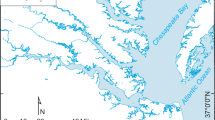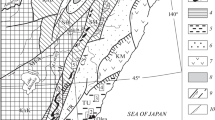Abstract
In the 23 years since Lowenstam (1962) first discovered the mineral magnetite in chiton teeth, many other organisms have been reported to be able to form this mineral as well (Blakemore, 1975; Gould et al., 1978; Frankel et al., 1979; Walcott et al., 1979; Kirschvink, 1981a; Walker and Dizon, 1981; Lins de Barros et al., 1981). Magnetite is now the fourth most common biogenic mineral after carbonate, opal, and ferrihydrite and related ferric oxide in terms of its production by different groups of organisms (Lowenstam and Weiner, 1982). A variety of magnetite-forming organisms live in aquatic environments and hence there is the question whether magnetite formed by organisms can be preserved in sediments. In particular, one group of magnetite-synthesizing organisms, the magnetotactic bacteria, are cosmopolitan in their aquatic distribution. Based on calculations considering their natural population density, sedimentation rates, and volume of magnetite per cell, the biologic contribution of magnetic remanence in sediments has been estimated by Kirschvink and Lowenstam (1979) to reach the 10−4 A/m level. Towe and Moench (1981) revised this estimate upwards to 10−3 A/m which is more compatible with the remanence generally observed in sediments.
Access this chapter
Tax calculation will be finalised at checkout
Purchases are for personal use only
Preview
Unable to display preview. Download preview PDF.
Similar content being viewed by others
References
Balkwill, D. L., Maratea, D., and Blakemore, R. P., 1980, Ultrastructure of a magnetotactic spirillum, J. Bacteriol. 141: 1399–1408.
Berner, R. A., 1964, Stability fields of the iron mineral in anaerobic marine sediments, J. Geol. 72: 826–834.
Blake, D. J., 1967, Cosmic ray effects and foraminifera extinctions at geomagnetic field reversals, Earth Planet. Sci. Lett. 3: 225–236.
Blakemore, R. P., 1975, Magnetotactic bacteria, Science 190: 377–379.
Blakemore, R. P., Frankel, R. B., and Kalmijn, Ad. J., 1980, South-seeking magnetotactic bacteria in the Southern Hemisphere, Nature 286: 384–385.
Bogue, S. W., and Coe, R. S., 1982, Successive paleomagnetic reversal records from Kawai, Nature 295: 399–401.
Butler, R. R., and Banerjee, S. K., 1975, Theoretical single-domain grain size range in magnetite and titanomagnetite, J. Geophys. Res. 80: 4049–4058.
Carpenter, R., Johnson, H. P., Johnson, and Twiss, E. S., 1972, Thermomagnetic behavior of manganese nodules, J. Geophys. Res. 77: 7163–7177.
Castaing, R., and Frederickson, K., 1958, Analyses of cosmic spherules with an X-ray microanalyse, Geochim. Cosmochim. Acta 14: 114–117.
Chester, R., and Aston, S. R., 1976, The geochemistry of deep sea sediments, in: Chemical Oceanography, Volume 6 (J. P. Riley and R. Chester, eds.), Academic Press, New York, pp. 281–390.
Cisowski, S., 1981, Interacting vs. non-interacting single domain behavior in natural and synthetic samples, Phys. Earth Planet Inter. 26: 56–62.
Deuser, W. G., Brewer, P. G., Jichells, T. D., and Commean, R. F., 1983, Biological control of the removal of abiogenic particles from the surface sea, Science 219: 388–391.
Doyle, L. J., Thomas, L. H., and Betzer, P. R., 1976, Black magnetic spherule fallout in the eastern Gulf of Mexico, Science 197: 1157–1159.
Drooger, C. W., Meulenkamp, J. E., Langereis, C. G., Wonders, A. A. H., Van der Zwaan, G. J., Drooger, M. M., Raju, D. S. N., Doeven, P. H., Zachariasse, W. J., Schmidt, R. R., and Zijderveld, J. D. A., 1979, Problems of detailed biostratigraphic and magnetostratigraphic correlation in the Potamida and Apostoli sections of the Creten Neogene, Utrecht Micropaleontol. Bull. 21.
Ehrlich, H. L., 1982, Geomicrobiology, Dekker, New York.
Ensley, R. A., and Verosub, K. L., 1982, A magnetostratigraphic study of the sediments of the Ridge Basin, Southern California and its tectonic and sedimentologic implications, Earth Planet. Sci. Lett 59: 192–207.
Evans, M. E., and Wayman, M. L., 1970, An investigation of small magnetic particles by means of electron microscopy, Earth Planet. Sci. Lett. 9: 365–370.
Evans, M. E., McElhinny, M. W., and Gifford, A. C., 1968, Single domain magnetite and high coer- civities in a gabbroic intrusion, Earth Planet. Sci. Lett. 4: 142–146.
Frankel, R. B., Blakemore, R. P., and Wolfe, R. S., 1979, Magnetite in fresh-water magnetotactic bacteria, Science 203: 1355–1356.
Fyfe, W. S., and Lonsdale, P., 1981, Ocean floor hydrothermal activity, in: The Sea, Volume 7 (C. Emiliani, ed.), John Wiley & Sons, New York, pp. 589–638.
Garrels, R. M., and Christ, C. L., 1965, Solutions, Minerals and Equilibria, Harper & Row, New York.
Geissman, J. W., Newberry, N. G., and Peacor, D. R., 1983, Discrete single-domain and pseudo-single- domain titanomagnetite particles in silicic glass of an ash-flow tuff, Can. J. Earth Sci. 20: 334–338.
Gould, J. L., Kirschvink, J. L., and Deffeyes, K. S., 1978, Bees have magnetic remanence, Science 201: 1026–1028.
Hackett, J. P., and Bischoff, J. L., 1973, New data on the stratigraphy, extent and geologic history of the Red Sea geothermal deposits, Econ. Geol. 68: 563–584.
Harrison, C. G. A., and Peterson, M. N. A., 1965, A magnetic mineral from the Indian Ocean, Am. Mineral. 50: 704–713.
Henshaw, P. C., and Merrill, R. T., 1980, Magnetic and chemical changes in marine sediments, Rev. Geophys. Space Phys. 18: 483–505.
Hunter, K. A., 1983, On the estuarine mixing of dissolved substances in relation to colloid stability and surface properties, Geochim. Cosmochim. Acta 47: 467–474.
Johnson, H. P., Lowrie, P., and Kent, D. V., 1975, Stability of anhysteretic remanent magnetization in fine and coarse magnetite and maghemite particles, Geophys. J. R. Astron. Soc. 41: 1–10.
Kirschvink, J. L., 1981a, Biogenic magnetite (Fe3O4): A ferrimagnetic mineral in bacteria, animals, and man, in: Ferrites: Proceedings of the International Conference Japan, 1980, pp. 135–137.
Kirschvink, J. L., 1981b, A rapid, non-acidic chemical demagnetization technique for dissolving ferric minerals, Eos 62: 848.
Kirschvink, J. L., 1982, Paleomagnetic evidence for fossil biogenic magnetite in western Crete, Earth Planet. Sci. Lett. 59: 388–392.
Kirschvink, J. L., and Gould, J. L., 1981, Biogenic magnetite as a basis for magnetic field sensitivity in animals, BioSystems 13: 181–201.
Kirschvink, J. L., and Lowenstam, H. A., 1979, Mineralization and magnetization of chiton teeth: Paleomagnetic, sedimentologic and biologic implications of organic magnetite, Earth Planet. Sci. Lett. 44: 193–204.
Laj, C., Jamet, M., Sorel, D., and Valente, J. P., 1982, First paleomagnetic results from Mio-Pliocene series of the Hellenic sedimentary arc, Tectonophysics 86: 45–67.
Langereis, C. G., 1979, An attempt to correlate two adjacent Tortonian marine clay in western Crete using magnetostratigraphic methods, Utrecht Micropaleontol. Bull. 21: 193–214.
Langereis, C. G., and Zachariasse, W. J., and Zijderveld, J. D. A., 1984, Late Miocene magnetobiostra- tigraphy of Crete, Mar. Micropaleontol. 8: 261–281.
Lins de Barros, H. G. P., Esquivel, D. M. S., Danon, J., and Oliveira, L. P. H., 1981, Magnetotactic algae, Acad. Bras. Cienc. Notas Fis. CBPF-NP-048/81.
Lovlie, R. W., Lowrie, W., and Jacobs, M., 1971, Magnetic properties and mineralogy of four deep-sea cores, Earth Planet. Sci. Lett. 15: 157–162.
Lowenstam, H. A., 1962, Magnetite in denticle capping in recent chitons (Polyplacophora), Geol. Soc. Am. Bull. 73: 435–438.
Lowenstam, H. A., and Weiner, S., 1982, Mineralization by organisms and the evolution of biomineralization, in: Biomineralization and Biological Metal Accumulation (P. Westbroek and E. D. de Jong, eds.), Reidel, Dordrecht, pp. 191–203.
Lowrie, W., and Heller, F., 1982, Magnetic properties of marine limestones, Rev. Geophys. Space Phys. 20: 171–192.
McCabe, C., Van der Voo, R., Peacor, D. R., Scotese, C. R., and Freeman, R., 1983, Diagenetic magnetite carries ancient yet secondary remanence in some Paleozoic sedimentary carbonates, Geology 11: 221–223.
Mackereth, F. H. J., 1971, On the variation in direction of the horizontal component of remanent magnetism in lake sediments, Earth Planet. Sci. Lett. 24: 414–418.
Mehra, O. P., and Jackson, M. L., 1960, Iron oxide removal from soils and clays by a dithionite-citrate system buffered with sodium bicarbonate, Clays Clay Miner. 7: 317–327.
Meulenkamp, J. E., Jonkers, A., and Spaak, P., 1979, Late Miocene to early Pliocene development of Crete, in: VI Colloquium on the Geology of the Aegean Region pp. 138–149.
Özdemir, Ö., and Banerjee, S. K., 1982, A preliminary magnetic study of soil samples from west-central Minnesota, Earth Planet. Sci. Lett. 59: 393–403.
Schwertmann, U., and Taylor, R. M., 1977, Iron oxides, in: Minerals in Soil Environments (J. B. Dixon and S. B. Weed, eds.), American Society of Agronomy, Madison, Wise., pp. 145–180.
Shanks, W. C., III, Bischoff, J. L., and Rosenbauer, R. J., 1981, Seawater sulfate reduction and sulfur isotope fractionation in basaltic systems: Interaction of seawater with fayalite and magnetite at 200–350°C, Geochim. Cosmochim. Acta 45: 1977–1995.
Smith, P. P. K., 1979, the identification of single-domain titanomagnetite particles by means of transmission electron microscopy, Can. J. Earth Sci. 16: 375–379.
Stober, J. C., and Thompson, R., 1979, Magnetic remanence acquisition in Finnish lake sediments, Geophys. J. R. Astron. Soc. 57: 727–739.
Sugimoto, T., and Matijević, E., 1980, Formation of uniform spherical magnetite particles by crystallization from ferrous hydroxide gels, J. Colloid Interface Sci. 74: 227–243.
Tarling, D. H., 1971, Principles and Applications of Paleomagnetism, Chapman & Hall, London.
Towe, K. M., and Moench, T. T., 1981, Electron-optical characterization of bacterial magnetite, Earth Planet. Sci. Lett. 52: 213–220.
Thompson, R., Bloemendal, J., Dearing, J. A., Oldfield, F., Rummery, T. A., Stober, J. C., and Turner, G. M., 1980, Environmental applications of magnetic measurements, Science 207: 481–486.
Valet, J. P., and Laj, C., 1981, Paleomagnetic record of two successive Miocene geomagnetic reversal in western Crete, Earth Planet. Sci. lett. 54: 53–63.
Valet, J. P., Laj, C., and Langereis, C. G., 1983, A study of the two different R-N geomagnetic reversals recorded at the same site, Nature 304: 330–332.
Verosub, K. L., 1977, Depositional and postdepositional processes in the magnetization of sediments, Rev. Geophys. Space Phys. 15: 129–142.
Walcott, C., Gould, J. L., and Kirschvink, J. L., 1979, Pigeons have magnets, Science 205: 1027–1029.
Walker, M. M., and Dizon, A. E., 1981, Identification of magnetite in Tuna, Eos 62: 850.
Zachariasse, W. J., 1979, Planktonic foraminifera from section Potamida. I. Taxonomic and phyletic aspects of keeled globorotaliids and some paleoenvironmental estimates, Utrecht Micropaleontol. Bull. 21: 129–166.
Zen, E., 1963, Components, phases, and criteria of chemical equilibrium in rocks, Am. J. Sci. 261: 919–942.
Author information
Authors and Affiliations
Editor information
Editors and Affiliations
Rights and permissions
Copyright information
© 1985 Plenum Press, New York
About this chapter
Cite this chapter
Chang, SB.R., Kirschvink, J.L. (1985). Possible Biogenic Magnetite Fossils from the Late Miocene Potamida Clays of Crete. In: Kirschvink, J.L., Jones, D.S., MacFadden, B.J. (eds) Magnetite Biomineralization and Magnetoreception in Organisms. Topics in Geobiology, vol 5. Springer, Boston, MA. https://doi.org/10.1007/978-1-4613-0313-8_36
Download citation
DOI: https://doi.org/10.1007/978-1-4613-0313-8_36
Publisher Name: Springer, Boston, MA
Print ISBN: 978-1-4613-7992-8
Online ISBN: 978-1-4613-0313-8
eBook Packages: Springer Book Archive




